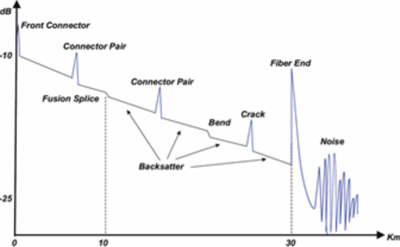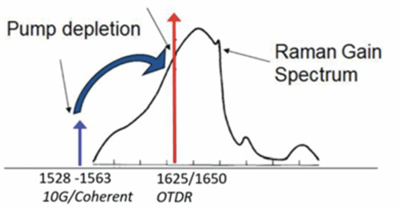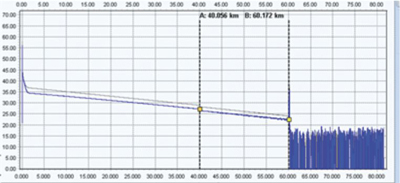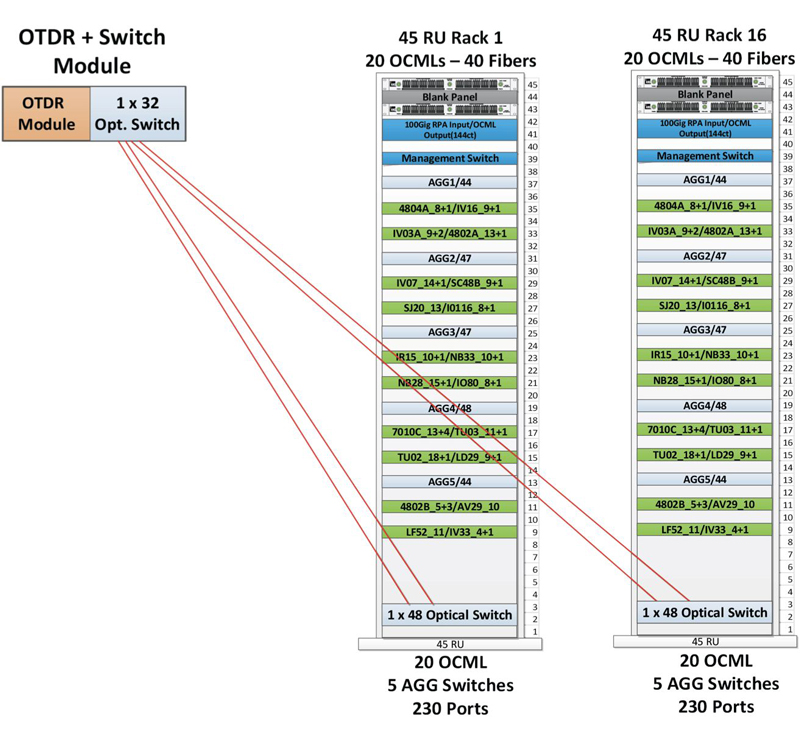In-Service OTDR in Access Networks
By Harj Ghuman and Nick DiPonzio
Continuous in-service (with traffic present) optical time domain reflectometer (OTDR) monitoring of the outside optical plant is an extension of proactive network maintenance (PNM) that will enhance network reliability and minimize network downtime. Outages caused by fiber cuts are a major reason for network disruption and increase as fiber moves deeper into the network. OTDR functionality is traditionally set up on dark fiber, however, this article presents in-service OTDR measurements done on fiber carrying live traffic. Technical issues such as Raman scattering and a method to conduct cost-effective, in-service OTDR measurements specific to the Cox access system-OCML are presented. Integration of OTDR functionality into the service assurance operating model and associated capabilities/benefits will be presented in a subsequent issue. The Cox access optical network utilizes an integrated module known as the OCML (optical communications module link extender) shown in Figure 1 (see Broadband Library Fall 2018). The OCML supports both residential (e.g., 10G optical feeds to remote PHY nodes) and business services from the same network, and can transport bi-directional 10G, GPON, 10GEPON and coherent 100G/200G signals on a primary or secondary backup fiber. The OCML incorporates OTDR ports which allow an OTDR pulse at 1625 nm or 1650 nm to be injected into both fibers via a WDM which was specified with a high degree of isolation between the OTDR pulse and traffic bearing C-band wavelengths. This combined with the innate isolation capabilities of OTDRs ensure that a clean signal is received by the OTDR.

Figure 1. Cox access network via the OCML
OTDR Fundamentals
An OTDR can identify a fiber cut location, verify splice loss, measure length and find other faults. It can be used to create a “picture” of new fiber optic cable and comparisons can be made between the original trace and a second trace taken if problems arise. The OTDR sends a high-powered pulse down the fiber; back-scattered and reflected light (from fiber impairments) returns to the OTDR through the fiber and is directed to a receiver via a WDM incorporated in the OCML. The amount of light received by the OTDR is proportional to the backscatter of the fiber, peak power of the OTDR test pulse and the length of the pulse sent out. Figure 2 shows how an OTDR diagnostic trace can reveal various fiber impairments, from splices to fiber ends (cuts). In-service OTDR measurement thus allows the fiber to be continuously monitored and provide timely information on any worsening fiber issues.

Figure 2. OTDR trace example
Raman Effects in In-Service OTDR
Live fiber OTDR testing requires a good understanding of the stimulated Raman scattering (SRS) crosstalk between the OTDR’s high-power 1625/1650 nm pulses and the 10G/coherent C-band traffic transported through the OCML-MDM. SRS causes depletion of the shorter (pump) wavelength and amplification of the longer (stokes) wavelength as depicted in Figure 3. It is greatest around the Raman gain peak when the stoke frequency is about 13 THz (~100 nm) from the pump’s frequency, which is the case between the C-band 10G/coherent traffic and the OTDR 1625/1650 nm signal. SRS is also dependent on the fiber length and the respective power levels of the OTDR and traffic bearing signals. SRS causes energy transfer from the C-band traffic signals to the OTDR pulse and can be significant for co-propagation systems where the OTDR pulse and traffic bearing wavelengths travel in the same direction, as would be the case in the OCML – MDM network. This energy transfer depletes the traffic bits’ amplitude and a small fraction of the traffic signal is scattered in the OTDR wavelength band. Figure 4 shows the SRS impact on the OTDR trace over 60 km of fiber, and a 17 dBm OTDR pulse power. It shows a 1.8 dB noise penalty which equates to a similar reduction in the dynamic range. Longer distances will experience a more severe noise penalty.

Figure 3. Stimulated Raman scattering

Figure 4. 1.8 dB SRS penalty with 17 dBm OTDR pulse
OCML Considerations
The OCML’s OTDR injection ports were specified with a degree of required isolation between the OTDR’s 1625/1650 nm and traffic bearing C-band wavelengths. This traffic could be 10G, PON or coherent 100G/200G. The OCML’s OTDR WDM isolation specification combined with the innate isolation capabilities of live traffic measurement OTDRs ensures the OTDR Rx receives a clean signal for trace processing. The additional insertion loss of 0.5 dB associated with the WDM required to inject the OTDR pulse and to protect transmit/receive equipment from the back-scattered or transmitted OTDR signals can be easily accommodated within the system link budget.
OTDR and Optical Switch Configuration
Conducting in-service OTDR of all fibers in an access network can be expensive if discrete OTDR modules are used for every fiber. One way to reduce the cost is to use a single OTDR module with a bank of optical switches which can continuously monitor many fibers. Figure 5 is an example of how a hub consisting of 320 OCMLs (640 fibers) can be configured for continuous in-service OTDR monitoring. In this scenario, the OTDR module plus a 1×32 optical switch is connected to 1×48 optical switches in each rack, allowing a total of 48 fibers to be monitored per rack. All 16 racks share the same OTDR module, allowing 640 fibers to be monitored.

Figure 5. OTDR and multiple optical switch connectivity
Conclusion
In-service OTDR monitoring of the outside plant is desirable to enhance network reliability and minimize downtime, especially since both residential and business services will be supported from the Cox access OCML – MDM network. This article presents technical issues to be considered for in-service OTDR monitoring, specifically SRS which can be an issue when the OTDR pulse co-propagates with C-band traffic such as 10G or coherent signals. A small amount of SRS noise reaching the OTDR port can be sufficient to raise the noise floor, create measurement errors and reduce dynamic range by 1.8 dB for a 17 dBm OTDR pulse, which is acceptable for Cox access networks. We have also presented a cost-effective solution for monitoring many fibers which utilizes a single OTDR module in conjunction with optical switches to continuously monitor all the fibers.
 Harj Ghuman
Harj Ghuman
Principal Engineer,
Cox Communications
Harj Ghuman is a Principal Engineer at Cox Communications, primarily focused on optical access architectures. He holds an M.S. degree in modern optics and microwaves and is recognized as a subject matter expert in fiber optics and millimeter wave (MMW) technologies. He has been instrumental in developing the patented concept of the OCML/MDM architecture for use in Cox’s remote PHY architecture. He has filed numerous patents and authored several technical papers.
 Nick DiPonzio
Nick DiPonzio
VP, Outside Plant Construction,
Cox Communications
Nick DiPonzio is Vice President, Outside Plant Construction & Engineering for Cox. His focus is on engineering and building reliable, simple and cost-effective solutions that meet customer expectations and business demands, delivering on Cox’s vision to be the most trusted provider of communication and entertainment services in America. Nick has held a number of roles in the telecommunications space and holds a Bachelor of Science in Electrical Engineering from the University at Buffalo.

